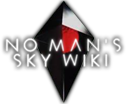| The subject of this article is from the Origins update.
The information from this article is up-to-date as of 9 November, 2020. |
The information from this article is up-to-date as of 9 November, 2020.
| This article was documented by the Galactic Hub. |
| Electric Diplo Carnival | |
|---|---|

| |
| Galaxy | Euclid |
| Region | The Arm of Vezitinen |
| Star system | HUB1-1 Tepper |
| Atmosphere | Hazy During the Day; More Clear at Night; Airborne Spores |
| Terrain | Huge Mountains; Plains with Rolling Hills; Shallow Lakes |
| Biome | Lush - Temperate Planet |
| Weather | Pleasant |
| Sentinels | Observant |
| Flora | Rich |
| Fauna | Abundant |
| Claimed by | Galactic Hub Project |
| Discovered by | epicdude312 |
| Discovery platform | PS4 |
| Updated | Origins |
Electric Diplo Carnival is a planet.
Summary[ | ]

Morning on the mountains of planet EDC.
Electric Diplo Carnival is a planet in the HUB1-1 Tepper system. It is notable for its warm-colored (red/orange/yellow/white) bioluminescent flora, its extreme topography, the presence of a large Theroma species, red bioluminescent Protocaeli species, and a lack of storms. Rainbows and meteors are also common on this planet.
This planet represents half of the Galactic Hub Rave Colony, with the other half being located on a sister bioluminescent-lush planet in the same system, Lepios. When building on this planet, players are encouraged to heavily utilize Bytebeat Devices, light-up / glowing objects (especially strobing or flashing), and other visually-appealing items resembling aspects of the bright colors and light shows associated with raves.
This planet's name is a reference to the popular festival / rave Electric Daisy Carnival. No actual diplos are found on this planet, only player-built statues.
Alias names[ | ]
| All | Original: | New Giumfo |
|---|
| PS4 | Current: | Electric Diplo Carnival |
|---|
| PC | Current: | New Giumfo |
|---|
| XBox | Current: | The World of the Willies |
|---|
Atmosphere & Climate[ | ]
- Maximum Temperature: 19.4 °C
- Minimum Temperature: 12.9 °C
- Storm Temperature: N/A
- Radioactivity (Rad): 0.5
- Toxicity (Tox): 5.3
Resources[ | ]
Life[ | ]
Fauna[ | ]
Zoology Scan Completion[ | ]
PS4:
PC:
XBox:
Flora[ | ]
| Name | Age | Root Structure | Nutrient Source | Notes & Resources |
Discovered By | |
|---|---|---|---|---|---|---|

|
A. Eildsenae (Big Freedom Shroom) | Ancient | Extensive | Soil Bacteria | Paralyzing Spores Carbon & Star Bulb These tree-sized mushrooms are found all over this planet. Branching from a single stem into four, the underside their caps flashes orange-red in waves across the planet's surface. The upper side of these caps are reddish-orange in coloration, |
7101334 |

|
Y. Claytoynii (Sunshine Shroom) | Juvenile | Concentrated | Fungal Reclamation | Ocular Irritant Carbon & Radon Very similar to A. Eildsenae (Big Freedom Mushrooms), the only major distinction between these two species is that this species displays a yellow bioluminescent coloration and green upper cap coloration. Small mushrooms with bright pink bioluminescence also grow on the primary stem, potentially parasitic in nature. |
7101334 |

|
X. Bugforima (Ecstatic Shroom) | Unknown | Widespread | Ultraviolet Radiation | Potentially Medicinal Carbon These mushrooms branch into four caps, similarly to A. Eildsenae and Y. Claytoynii, but are consistently much smaller in size. They glow with a deeper red coloration as compared to A. Eildsenae. Small mushrooms with bright pink bioluminescence also grow on the primary stem, potentially parasitic in nature. The upper side of the caps are red, fading to reddish-orange around the rims. |
Discoverer |

|
Y. Brimposileum (Joyburst) | Sapling | Conjuration | Conjuration | Extremely Poisonous Carbon & Sulphurine This large bioluminescent fungus seems to consistently branch into two main stalks, which terminate in clustered radial offshoots, forming a crowning sphere of yellowish-white pulsing fruiting bodies. This species is common and easy to locate due to its height. |
7101334 |

|
Y. Westgebum (Ego Antidote) | Timeless | Bi-directional | Natural Carbon | Altitude Tolerant Carbon & Radon These mushrooms are some of the only mushrooms on this planet which do not grow in clusters or form multiple stems. They are roughly the same height as your average traveler, and the umbrella-shaped caps flash with yellowish-white bioluminescence at night, except for a dark ring around the outside of the cap which does not glow. They are roughly the height of a traveler's shoulders, and usually grow at a slight angle. |
7101334 |

|
Y. Waftutlima (Tumbleshroom) | Ancient | Substantial | Radio Waves | Self-Pollinating Carbon & Faecium This species resembles the radial offshoots of Y. Brimposileum except with no stalk and only a single cluster per individual. Their bioluminescence is orangeish-white in color. |
7101334 |

|
V. Baylilia (Witch's Hat) | Juvenile | Transferrable | Infrared Radiation | Annual Spore Clouds Carbon & Faecium These small mushrooms grow in clusters of three. Reddish in coloration, the tops of the caps flash with an orange bioluminescence, especially towards the tips. Their name originates from the elongated, conical shape of the caps. |
7101334 |

|
D. Pipyimnae (Spirit Shroom) | Ancient | Many-Limbed | Theft | Carbon Dense Carbon These small mushrooms grow in clusters of three. Light blue in coloration with bands of purple and black on the tops of the caps, the tops of the caps flash blueish-white with bioluminescence. The caps are umbrella-shaped with a slight point towards the center. |
7101334 |

|
Q. Thiefsumea (Cloud Bouncers) | Millennia | Invasive | Photosynthesis | Edible Seeds Carbon & Oxygen These small mushrooms grow in clusters of three. Their rounded, short caps flash with orange biolumiunescence. |
7101334 |

